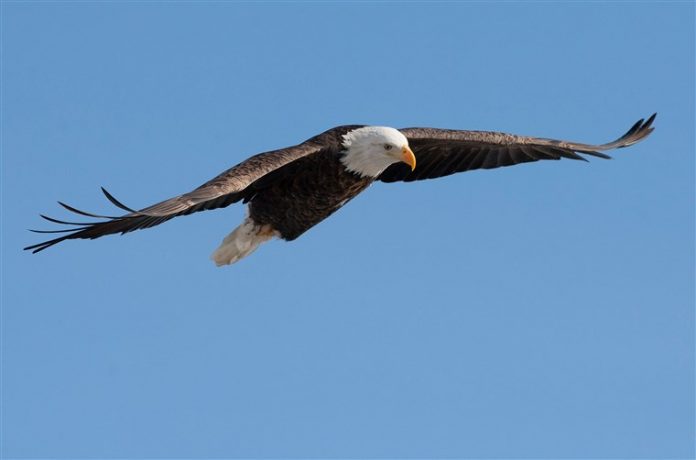In what state officials are describing tongue-in-cheek as a “brazen attack,” a bald eagle recently snatched a $950 drone belonging to the state of Michigan that was being flown to document shoreline erosion damage in the Upper Peninsula. After a brief tussle, the big bird ripped off one of the propellers from the small spinning aircraft and sent it to the bottom of Lake Michigan near Escanaba, state workers said.
The drone was being operated by a pilot for the Michigan Department of Environment, Great Lakes, and Energy (EGLE) when the July 21 attack occurred. Is the department’s acronym a coincidence when considering the predator? The state thinks not.
“The attack could have been a territorial squabble with the electronic foe, or just a hungry eagle. Or maybe it did not like its name being misspelled,” the department said in a news release today. “EGLE’s drone team is considering steps to reduce the possibility of a repeat attack, including possibly using ‘skins’ or other designs on the aircraft to make them look less like seagulls.”
Here’s what we know about the airborne attack:
EGLE quality analyst and drone pilot Hunter King was on his fourth mapping run of the day with the drone, capturing images of shoreline erosion so the state agency can document how recent high-water levels have affected the Great Lakes and give them data on which communities need help coping with damage.
The pilot said the drone was about seven minutes into its mapping flight when he noticed that its satellite reception was getting weak. “He pressed the ‘Go Home’ recall button. The drone dutifully turned, reacquiring a strong satellite feed,” the agency said.
“King was watching his video screen as the drone beelined for home, but suddenly it began twirling furiously,” like a bad rollercoaster ride, he told the department.
“When he looked up, the drone was gone, and an eagle was flying away. A nearby couple … later confirmed they saw the eagle strike something but were surprised to learn it was a drone. Both King and the couple said the eagle appeared uninjured as it flew from the scene of the crime.”
King and the couple all searched for the drone, but found nothing.
Flight data showed the drone had hit the lake about 150 feet from shore, and landed in 4 feet of water. Employees used that information days later when they returned to search for the little aircraft.
“EGLE Unmanned Aircraft Systems coordinator Arthur Ostaszewski brought a kayak and snorkeling gear to the search. With near-zero visibility in water darkened by tannin, Ostaszewski scrapped the snorkel and instead walked a grid pattern shuffling his feet for two hours in soft muck (“like I was playing Battleship and wanted to cover the entire board”). He too was luckless, abandoned the search when lightning began to accompany a cold drizzle.”
The drone was a Phantom 4 Pro Advanced, which will be replaced, the department said.
Here were the ill-fated flight’s final moments, according to the drone data released by EGLE:
The eagle strike occurred 7:39.7 into the flight, roughly four-tenths of a mile from King and 162 feet above the water.
Its speed instantly dropped from 22 mph to 10. Within a half-second, the flight record shows the beginning of downward spiral along with “excessive spinning” warnings.
In the next 3.5 seconds the drone sent 27 warning notifications including one indicating a propeller had been torn off.
Gaining momentum as it fell, its last communication came at 34 feet above the water, falling at 30 feet per second, or 20.4 mph.
Eagles have enjoyed a nice uptick in Michigan in recent years, the state said. In 2019, a federal survey found 849 active nesting sites in the Upper and Lower Peninsulas. This is a big jump compared to the low numbers of the 1970s, which saw just 76 nesting sites in some years.
A little more levity from the EGLE staff: They said they contacted the DNR hoping to get a citation issued to the rogue eagle.
































